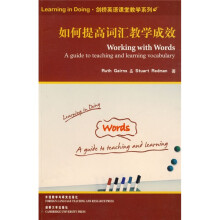Acknowledgements
Preface
PART A WORDS:THEIR MEANIGS AND FORMS
1 Language awareness activities
2 Words and their meanings
2.1 Conceptual meanin9
2.2 Affective meanin9
2.3 Style,register and dialect
2.4 Sense relations
2.4.1 Synonymy
2.4.2 Hyponymy
2.4.3 Antonymy
2.4.4 0ther types of relations
2.4.5 Translation equivalents
2.5 Multi.word verbs
2.6 Idioms
2.7 Collocation
2.8 Componential analysis
3 Words and theirforms
3.1 The grammar of vocabulary
3.2 Word building
3.3 Pronunciation
PART B PRINCIPLES IN LEARNING ADN TEACHING VOCABULARY
4 Decisions about content
4.1 Student responsibility and teacher responsibility
4.2 Criteria for selection
4.2.1 Frequency
4.2.2 Cultural factors
4.2.3 Need and level
4.2.4 Expediency
4.3 Receptive vcrsus productive vocabulary
4.4 HOW many iterns to teach
4.5 Grouping of items of vocabulary
5 How the learner discovers meanin9
5.1 Traditional approaches and techniques used in the presentation of new vocabulary iterns
5.1.1 Visual techniques
5.1.2 Verbal techniques
5.1.3 Translation
5.2 Student.centred learnin9
5.2.1 Asking others
5.2.2 Using a dictionary
5.2.3 Contextual guesswork
6 Memory and written storage
Teoretical aspects
6.1 Types of memory
6.2 Organisation of the mentallexicon
6.3 Why do we forget?89
Practical implications
6.4 Meaningful tasks
6.5 lmagery
6.6 Rote learning
6.7 Recyclin9
6.8 Written storage systems for Iearners
PART C CLASSROOM ACTIVITIES
7 Using visuaI aids
7.1 Using pictures as a guide to meanin9
7.2 Using pictures for further practice
8 Using authentic reading texts
9 Teacher designed contexts and the use of the dictionary
10 Speaking activities
10.1 Role play
10.2 Narrative
10.3 Processes,priorities and appropriacy
11 Games,questionnaires and problem solving
PART D VOCABULARY IN COURSE BOOKS
12 Vocabulary in course books
12.1 Checklist
12.2 Extracts from course books
Key
Bibliography
Index

 缺书网
缺书网 扫码进群
扫码进群






